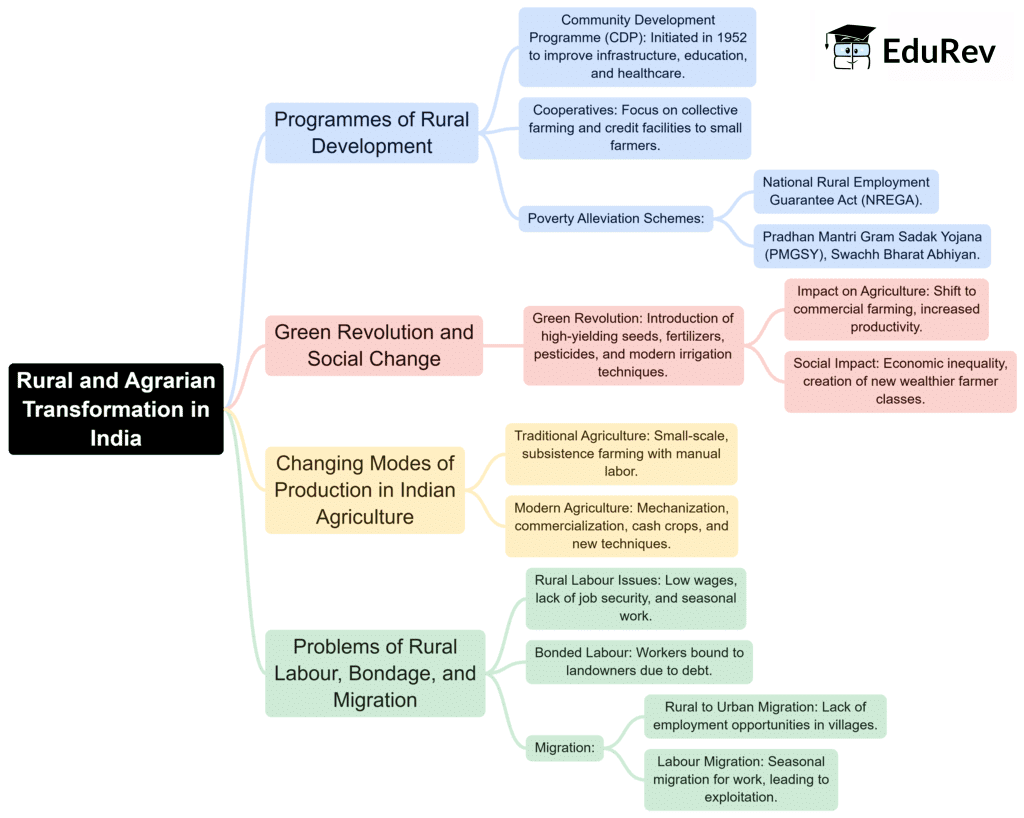UPSC Exam > UPSC Notes > Sociology Optional for UPSC (Notes) > Mind Map: Rural and Agrarian Transformation in India
Mind Map: Rural and Agrarian Transformation in India | Sociology Optional for UPSC (Notes) PDF Download

The document Mind Map: Rural and Agrarian Transformation in India | Sociology Optional for UPSC (Notes) is a part of the UPSC Course Sociology Optional for UPSC (Notes).
All you need of UPSC at this link: UPSC
|
112 videos|389 docs
|
FAQs on Mind Map: Rural and Agrarian Transformation in India - Sociology Optional for UPSC (Notes)
| 1. What are the key components of rural and agrarian transformation in India? |  |
Ans. The key components of rural and agrarian transformation in India include technological advancements in agriculture, changes in land use patterns, diversification of livelihoods, rural infrastructure development, and the role of government policies and programs aimed at enhancing agricultural productivity and rural development.
| 2. How has agricultural policy evolved in India post-independence? |  |
Ans. Post-independence, agricultural policy in India has evolved through various phases, including the introduction of land reforms, the Green Revolution aimed at increasing food production, and recent initiatives focused on sustainable agriculture and farmer welfare. The shift towards market-oriented policies and the introduction of schemes like PM-KISAN reflect ongoing changes in agricultural policy.
| 3. What are the challenges faced by the agrarian sector in India today? |  |
Ans. The agrarian sector in India faces several challenges, including inadequate irrigation facilities, dependency on monsoon, land degradation, declining soil fertility, poor access to credit, fluctuating market prices, and the impact of climate change. Additionally, smallholder farmers often struggle with limited access to technology and markets.
| 4. What role do cooperatives play in rural transformation in India? |  |
Ans. Cooperatives play a crucial role in rural transformation in India by empowering farmers through collective bargaining, providing access to credit, inputs, and technology, and facilitating better market access. They also help in enhancing the income levels of farmers and promoting sustainable agricultural practices.
| 5. How do government schemes support rural and agrarian transformation? |  |
Ans. Government schemes support rural and agrarian transformation by providing financial assistance, promoting technology adoption, improving infrastructure, and ensuring food security. Programs like the Mahatma Gandhi National Rural Employment Guarantee Act (MGNREGA) and the Pradhan Mantri Awaas Yojana (PMAY) are designed to improve rural livelihoods and living conditions, thereby contributing to overall rural development.
Related Searches





















